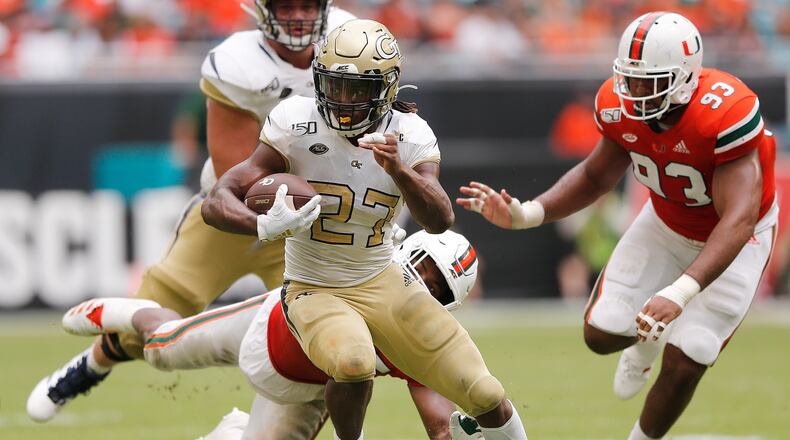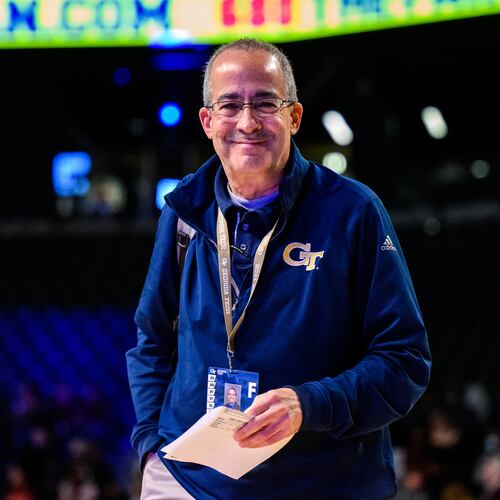Georgia Tech’s opening drive of the second half against Miami on Oct. 19 did not yield points. The Yellow Jackets started at their own 4-yard line and reached the Hurricanes’ 34 before a false-start penalty pushed them out of field-goal range.
However, that drive may have been a crystallization of what coach Geoff Collins and offensive coordinator Dave Patenaude would like to see out of the Tech offense over the final five games of the regular season. If the Jackets can move the ball behind an improving offensive line and the skillful play of running back Jordan Mason, that would quite satisfy Patenaude.
“I think the greatest part about what we did against Miami was we were able to control the clock, made a concerted effort to run the ball out of a multitude of different looks,” Patenaude said.
Before the Miami game, Tech had a 61/39 run/pass ratio, a balance that varied game by game. The ratio against the Hurricanes was 45/19, the fewest number of passes since the loss to The Citadel (when Tech ran only 46 plays) and the highest number of runs since the win over South Florida.
That run reliance was on full display when the Jackets dug out from deep in their own end with a variety of run plays. Over 14 plays, Tech called nine runs, including a jet sweep to slot receiver Tobias Oliver that technically was a pass as quarterback James Graham shoveled the ball forward to Oliver as he ran by.
In the 14 plays, Tech used four personnel groupings and used variations of seven formations. Patenaude lined up two tight ends outside left tackle Zach Quinney and ran Mason behind them, picking up a third-and-9.
Tech ran a triple-option, with Graham pulling the ball from a mesh with Mason and pitching the ball to running back Jerry Howard for a 10-yard gain. There were read-option gives and keeps. In a two-back set, running back Jamious Griffin ran up the middle behind Howard. In all, five players – Griffin, Mason, Howard, Graham and Oliver on the jet sweep – had carries, gaining a total of 45 yards.
“It wasn’t just, hey, we’re going to line up in two tight ends and just try to pound the ball down your neck,” Patenaude said, speaking of the game as a whole. “We gave the ball to Mason, and you had all the auxiliary runs off of that. Jamious played well and Jerry played well, so we have a good group of those guys.
“But in the same respect, we spread people out and we were bringing Tobias in motion and handing him the speed sweep and trying to be spread – two tight ends, two backs – giving them different looks. And then take your shots off of that. I think that is a good recipe.”
The run threat that Graham poses is a dimension that not many offenses have, adding to the diversity of the Tech run game. Graham has the speed to outrun linebackers and safeties to the perimeter and also had an impressive interior run during that opening drive of the second half, crashing into Miami linebacker Shaquille Quarterman (241 pounds to Graham’s 192) to pick up a third-and-3.
“The ability of James to pull the ball and be a viable weapon pulling the ball really put Miami into some disadvantages when they were trying to defend some of the run game,” Patenaude said.
The drive also consumed 7:58, not a small consideration for Tech’s defense.
“We played good defense when (the offense) was on the field,” defensive coordinator Andrew Thacker said wryly. “Dave and the crew did an unbelievable job of complimentary football and controlling the clock. That allowed us to be the defense that was the most motivated going into overtime, the freshest and had the most live bodies, and I think you saw that in the fifth period.”
The results of Tech’s pass plays also helps explain the emphasis on the run. On the first pass, Graham was chased out of the pocket and threw incomplete. He also had a pass batted down and was later sacked. There were two completions, a quick-hitting pass to Oliver for a conversion of a third-and-8 and another quick release to tight end Dylan Deveney for a 10-yard gain. Graham is developing, and slot receiver Ahmarean Brown has proved his worth as a home-run threat, but the pass game remains inconsistent.
For Tech’s game Saturday against Pitt, a game plan leaning heavily to the run might be well-advised. The Panthers lead FBS in sacks with 38, and Patenaude stressed the dire need to avoid third-and-long.
Pitt isn’t particularly soft against the run, though. The Panthers rank sixth nationally in run defense at 85.9 rushing yards allowed per game. That said, Miami was giving up an average of 77.8 yards per game before allowing 207 to the Jackets.
The orientation of controlling the game and the clock with the run, of course, is not a new strategy at Tech. Former coach Paul Johnson used it to great effect over his 11 years with the Jackets.
Patenaude has historically been 50/50 in run/pass ratio, and the Jackets may get closer to that rate over the final run games than they were against Miami. But with Mason and Graham around, the run will be the basis.
“You have to be able to establish the run, no matter what,” Patenaude said.
About the Author
Keep Reading
The Latest
Featured


